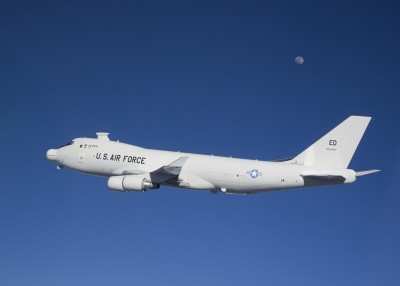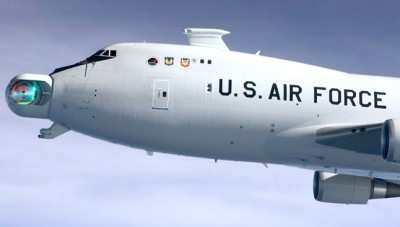Fri, Oct 29, 2010
But One Analyst Says The Program Has Merit
In the most recent test of the airborne laser being developed as
part of a missile defense program, the target was successfully
acquired and tracked by the equipment aboard a specially-modified
B747 off Point Magu, CA, but the megawatt class lethal chemical
laser failed to switch on to destroy it.

File Image
Riki Ellison, Founder and Chairman of the Missile Defense
Advocacy Alliance (MDAA), said in a statement that the test should
not be considered a setback to the program.
"This marks the second time out of five attempts to engage the
chemical laser of the Airborne Laser Test Bed (ALTB) this year that
the lethal megawatt chemical laser was turned off automatically for
safety reasons or was not switched on when electronically signaled
to do so. The first failure, which was caused by a hardware issue,
happened in a similar test last month while the most recent test
failure was caused by a software issue. Both of these issues are
easily solved and do not create an engineering barrier or block to
the further successful development of the program."
Ellison points out that the system has successfully engaged
three targets during the test program. "he program remains a
precious technological trail blazer that keeps the United States
well ahead of other nations chasing these similar technologies
while giving our military a functional test bed to leap forward.
The ALTB system has achieved a number of historic engineering
breakthroughs."
The analyst says that the program has been cut back severely by
the Department of Defense (DOD) and the administration due to the
projected affordability of an operational system, and that the
number of people working on the program has been reduced by close
to 75 percent over the past year and has been made into a test and
risk reduction platform; losing a significant amount of critical
skills, expertise and knowledge in the subject matter.

File Image
"The ALTB funding request of $99 million in 2011 is a very small
investment of the overall $8.4 billion Missile Defense Agency
budget request to continue working out glitches in the system and
testing the megawatt class chemical laser at greater ranges," he
said. "With greater support this coveted research and development
program offers risk and cost reductions in all directed energy
laser engagements from solid state, electric (diode pumped alkali
lasers, DPALs), and chemical means."
Ellison says that in order for the expectations of laser
development to be met, more testing and research needs to be done.
"There have been five high power laser tests conducted this year
with a possible sixth before the end of December. There are
currently only two high power laser tests with a much reduced
budget scheduled in 2011."
More News
Witness Reported The Airplane Was Flying Low And Was In A Left Bank When It Struck The Power Line Analysis: The pilot was on final approach to land when the airplane collided with >[...]
How To Get A Story On Aero-TV News/Feature Programming How do I submit a story idea or lead to Aero-TV? If you would like to submit a story idea or lead, please contact Jim Campbel>[...]
From 2012 (YouTube Edition): A Segment Of The Sport Aviation World That Truly Lives "Low And Slow" Pity the life of ANN's Chief videographer, Nathan Cremisino... shoot the most exc>[...]
Aero Linx: International Business Aviation Council (IBAC) IBAC promotes the growth of business aviation, benefiting all sectors of its industry and in all regions of the world. As >[...]
Execute Missed Approach Instructions issued to a pilot making an instrument approach which means continue inbound to the missed approach point and execute the missed approach proce>[...]
 NTSB Final Report: Cozy Cub
NTSB Final Report: Cozy Cub ANN FAQ: Contributing To Aero-TV
ANN FAQ: Contributing To Aero-TV Classic Aero-TV: Seated On The Edge Of Forever -- A PPC's Bird's Eye View
Classic Aero-TV: Seated On The Edge Of Forever -- A PPC's Bird's Eye View ANN's Daily Aero-Linx (04.29.25)
ANN's Daily Aero-Linx (04.29.25) ANN's Daily Aero-Term (04.29.25): Execute Missed Approach
ANN's Daily Aero-Term (04.29.25): Execute Missed Approach




